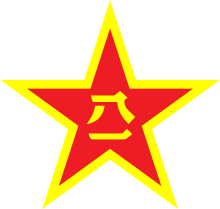74th Group Army
| 74th Group Army | |||||
|---|---|---|---|---|---|
 | |||||
| Active | 1949-present | ||||
| Country | |||||
| Branch | |||||
| Type | Field army | ||||
| Size | Corps | ||||
| Garrison/HQ | Huizhou, Guangdong | ||||
| Engagements | Korean War Sino-Vietnamese War | ||||
| Commanders | |||||
| Current commander | Major General Hong Jiangqiang | ||||
| Political commissar | Major General Liu Hongjun | ||||
| Notable commanders | Li Zuocheng | ||||
| Insignia | |||||
| NATO Map Symbol |
| ||||
The People's Liberation Army Ground Force 74th Group Army, formerly the 42nd Group Army, is a group army - a corps-sized military formation - of the Chinese People's Liberation Army, active since the late 1940s. It was part of the Guangzhou Military Region.[1][2]
History[]
During the Korean War, the Army was part of the People's Volunteer Army (Chinese People's Volunteers (CPV) or Chinese Communist Forces (CCF)) XIII Army Group. It was composed of the 124th, 125th, and 126th Divisions.[3]
During the Korean War, the 42nd Army was commanded by Lieutenant General .[4]
Major CPV forces did not enter Korea until the night of Oct. 16, 1950, when the 124th Division, of the 42nd Army of the XIIIth Army Group crossed the Yalu River opposite Manp'ojin.[5] On the 16th it started on foot from Manp'ojin, marching southeast through Kanggye and Yudam-ni to Hagaru-ri. From there its advanced elements proceeded to the point south of the Changjin Reservoir where they met the ROK 26th Regiment on 25 October. The remainder of the division moved up to the point of contact and joined in the battle near Sudong against the U.S. 1st Marine Division troops that replaced the ROK 26th Regiment.[6]
The 42nd Army and the 38th Army were pouring through the broken South Korean lines to Eighth Army’s east and threatening to envelop the entire force.[7]
The west flank units of this army, elements of the 125th Division, overlapped into the Eighth Army zone and apparently constituted the enemy force that dispersed the ROK 7th Regiment below Ch'osan at the end of October 1950.[8]
In October 1952 the replaced the 42nd Army and they were rotated back to China.
References[]
- ^ PLA Ground Forces Archived August 19, 2007, at the Wayback Machine
- ^ Huang, Kristin (January 18, 2018). "How China's military is girding for battle, and what it means for neighbours". South China Morning Post. Retrieved January 19, 2018.
- ^ Appleman, Roy E. (1992) [1961]. "Chapter XXXIX The Big Question". South to the Nakton, North to the Yalu. United States Army in the Korean War. United States Army Center of Military History. p. 768. CMH Pub 20-2-1.
- ^ Chinese Lieutenant General Wu Ruilin, Activities in Korean War
- ^ Korean War FAQ, from CenturyChina.com
- ^ Appleman, Roy E. (1992) [1961]. "Chapter XXXVI The Big Question". South to the Nakton, North to the Yalu. United States Army in the Korean War. United States Army Center of Military History. p. 719. CMH Pub 20-2-1.
- ^ Stewart, Richard W. The Korean War: The Chinese Intervention. United States Army Center of Military History. p. 12. CMH Pub 19-8.
- ^ Appleman, Roy E. (1992) [1961]. "Chapter XXXIX The Big Question". South to the Nakton, North to the Yalu. United States Army in the Korean War. United States Army Center of Military History. p. 767. CMH Pub 20-2-1.
- Field armies of the People's Volunteer Army
- Field armies of the People's Liberation Army
- Military of Huizhou
- Guangzhou Military Region
